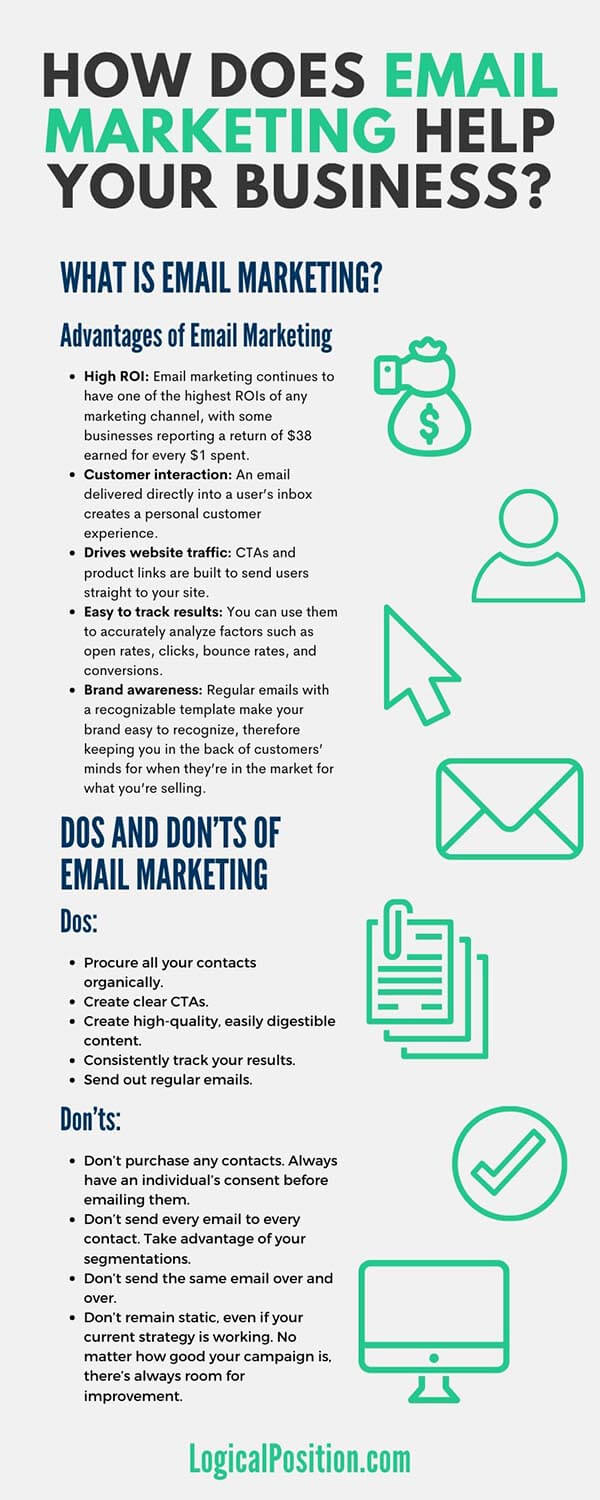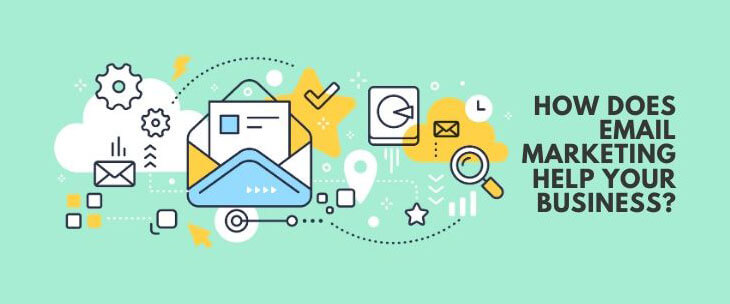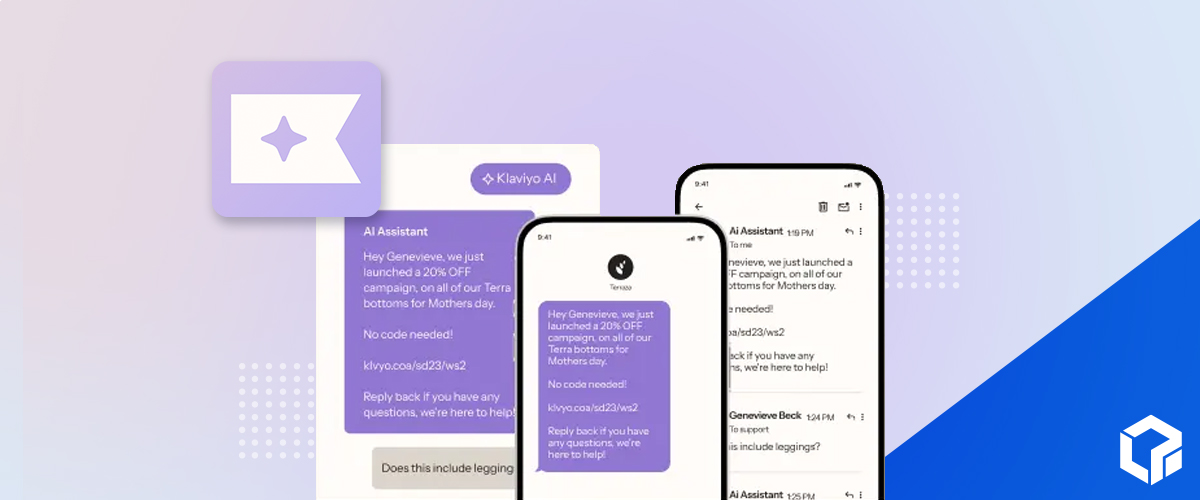What Is Email Marketing?
This is a question that seems alarmingly simple on the surface. Anyone unfamiliar with online marketing may not know much about SEO or PPC, but we’re all familiar with the business emails we’ve received in our inbox since we first created our accounts.
Business owners would do well to acquaint themselves with the nuances of email marketing and apply them to their companies. While some may initially dismiss email marketing as archaic and old-fashioned, it has proven to be vital in helping businesses overcome economic challenges. Email marketing holds a place of seniority in the digital marketing world and continues to be one of the strongest players. In today’s article, we explore the advantages of email marketing and several ways it can be used to further the success of your business.
Advantages of Email Marketing
- High ROI: Email marketing continues to have one of the highest ROIs of any marketing channel, with some businesses reporting a return of $38 earned for every $1 spent. This sits anywhere from 2 to 4 times higher than other marketing avenues.
- Customer interaction: An email delivered directly into a user’s inbox creates a personal customer experience. After taking the time to define and understand your target audience, you can use email marketing to interact with your audience by not only sharing what you have to offer but also by requesting feedback and sending surveys.
- Drives website traffic: CTAs and product links are built to send users straight to your site. You can use segmented lists and relevant landing pages to target the people most likely to click first on your email, and then the links inside it.
- Easy to track results: Many email service providers today make it incredibly easy to track the results of your campaign. You can use them to accurately analyze factors such as open rates, clicks, bounce rates, and conversions.
- Brand awareness: You can build a loyal customer base by using consistent branding. Regular emails with a recognizable template make your brand easy to recognize, therefore keeping you in the back of customers’ minds for when they’re in the market for what you’re selling.
Automated and Manual Sends
In order to build a successful campaign, you’ll want to take advantage of both manual and automated sends. Automated emails are direct responses to an action taken by a customer, while manual sends are regular newsletters and promotions you’ll send to customers to keep them updated on what’s new in your business. Both options are essential if you want to build out a fully rounded email campaign.
Automated Sends
As mentioned above, automated sends—oftentimes known as drip campaigns—are a direct response to an action taken by a user, usually on your site. These communication lines encourage sales and are extremely hyper-targeted. As a result, they oftentimes bring in high volumes of traffic and conversions. These emails are triggered by actions such as someone adding an item to their cart or their personal sales patterns. By using automated sends, you’re exposing customers to something they’re already interested in. The following are examples of automated sends:
- Welcome emails
- Abandoned cart
- Browse abandonment
- Shipping confirmation
- Customer thank-you
- Customer win-back
- Cross-sell/upsell
Manual Sends
A manual send is a unique email meant to be sent out only once—though they’ll occasionally be resent to subscribers who didn’t open the original email. Some businesses will send these out monthly, while others will opt for weekly sends. Keep in mind that there’s no set rule for how many emails a business owner should send. When first starting your campaign, you may want to start small and take time to evaluate subscriber engagement. As you grow your campaign, you may increase the amount of manual sends you create.
Manual sends are usually meant to keep customers up-to-date on new product offerings or special discounts. These emails appeal to brand enthusiasts who enjoy being in the know. They keep customers informed of the brand, what they’re doing, and how they’re doing it. Manual sends work in conjunction with automated ones as they serve to drive a customer to a site, therefore triggering automations such as browse abandonment. We can almost think of the two like fraternal twins—they complement each other so well that it would be impossible to imagine one without the other by its side.
Segmentations
Segmentations are an incredibly important part of email marketing and one of its best advantages. They allow you to send emails to the right people as opposed to blasting them to every subscriber you have. There’s nothing wrong with sending an email to fewer people if it means that it will improve open rates and decrease bounce rates and users unsubscribing. Note that many email servers determine the value of an email according to the percentage of recipients who have opened them.
What Can You Segment Audiences By?
Answering this here may seem impossible because the types of segmentations you can create are almost limitless. However, businesses getting started with email marketing can start with these basics:
- Past purchases
- Email engagement
- Location
- Buying frequency
- Page views
- Product category preferences
A/B Testing
A/B testing essentially consists of sending out the same email with minor variations to your contact list. Each business is completely unique, even when they’re in the same industry, and A/B testing allows you to gather data to learn what your specific audience wants. To accurately track results, you’ll want to send each variety to an even number of subscribers. When A/B testing, you’ll want to begin sending to a small portion of your audience and gather the results to determine which variation receives the best result. This way, you can ensure that a majority of your audience receives the higher-performing email, therefore creating more conversions.
What Can You A/B Test?
There are a few different items you can A/B test, which we’ll list below. What’s important to note is that, in order to really get accurate results, you’ll only want to A/B test one aspect of your email at a time. When you look at these bullet points, don’t try to implement all of these at once. Additionally, you may need to test one thing for several months to truly determine which works best. With that in mind, here are a few items you may want to test:
- There are a variety of tests businesses may use in subject lines. These include the number of characters, emojis vs. no emojis, and a question vs. a statement.
- The length of copy in your email.
- What time you send out an email.
- Your call to action.
- There are several tests you can deploy with graphics, such as colors and imagery.
Lead Gen vs. E-Commerce
Any business falls into the category of either lead generation or e-commerce. How you’ll explore any marketing avenue—be it email, SEO, or PPC—will vary greatly depending on which type of business you run. What your audience is looking for and how they’ll respond can vary depending on whether your business is lead gen or e-commerce.
Lead Gen
Lead gen email campaigns are for local and service-based industries. These are oftentimes sent in a newsletter form and are more text-heavy. Instead of being sales-y, lead gen emails oftentimes take a more bloglike, informational approach. The ideal motto for lead gen is “Content is king!”
The traffic from lead gen tends to come in the form of call volume or forms that subscribers fill out as opposed to a direct online purchase. For this reason, results can be more difficult to track with these types of industries, which can cause some business owners to assume that they aren’t seeing positive results and therefore deter them from running a campaign. However, email marketing is extremely valuable with lead gen because it allows you to form personal relationships with your clients and regularly remind them of your business.
E-Commerce
E-commerce campaigns are ones that are product-based. E-commerce emails are oftentimes used to announces sales and new products and tend to be more visual than lead gen sends. E-commerce can be used for businesses that are B2B, B2C, or both. Even though they’re both e-commerce, B2B and B2C emails still tend to be framed a bit differently. B2B emails are typically more informational and avoid CTAs that are too sales-y, whereas it’s a bit more common for B2C emails to be a touch more heavy-handed.
The results curated by e-commerce emails are easy-to-track conversions on your site and allow you to accurately detect room for improvement. They’re extremely valuable in driving brand awareness and customer loyalty.
Dos and Don’ts of Email Marketing
In this article, we’ve given an outline of the most important aspects of email marketing. Here we’d like to round out our guide with a few basic dos and don’ts.
Dos:
- Procure all your contacts organically.
- Create clear CTAs.
- Create high-quality, easily digestible content.
- Consistently track your results.
- Send out regular emails.
- Be creative! Let what makes your brand and guiding principles shine through in order to build real relationships with your customers.
- Use pop-ups—these are much more effective and likely to catch a user’s attention than an embedded sign-up form in your website’s footer. If you can, offer users a discount for signing up for emails.
- Integrate your email marketing with your social media. Using the data extracted from email marketing efforts allows you to better target your real demographics through social media and ads.
Don’ts:
- Don’t purchase any contacts. Always have an individual’s consent before emailing them.
- Don’t send every email to every contact. Take advantage of your segmentations.
- Don’t send the same email over and over.
- Don’t remain static, even if your current strategy is working. No matter how good your campaign is, there’s always room for improvement.

How Logical Position Can Help
Whether you don’t have an email campaign yet or you do have one but don’t have the time or expertise to manage it, we at Logical Position would love to help. Our experts in targeted email marketing services have helped an assortment of businesses use emails to connect with clients and grow their brand.
If you have any questions or want to learn more, our team is ready to help you discover your email marketing potential with a free review of your account. To learn more, visit our page featuring our different packages and get in touch today!




